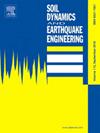Scaling P and S wave translational to array-derived rocking motions: An empirical estimation of local wave propagation direction and velocity in rock site conditions
IF 4.2
2区 工程技术
Q1 ENGINEERING, GEOLOGICAL
引用次数: 0
Abstract
We analyze the rotational motions of 484 earthquakes in the 0.7 to 1.8 range that were induced by the 2018 geothermal stimulation in the Helsinki, Finland, metropolitan area, located in the cratonic Fennoscandian Shield environment. The rotational motions of and waves in the 2 Hz–15 Hz frequency band are calculated from translational geophone array seismograms recorded in a 1.4 km–4.9 km epicentral distance range. We observe maximum peak rocking rates of mrad/s for the wave and mrad/s for the wave. We show that the ratio of the computed peak rocking rates to the observed peak vertical acceleration yields a good approximation of the local apparent wave velocity. For this, the rotational motions are obtained in the local coordinate system that minimizes rotation about the radial axis. This analysis indicates variations in the back-azimuth from the great-circle direction which are associated with structural subsurface heterogeneities. Our comparison with results from synthetic waveforms and results from a delay-and-sum plane wave beamforming analysis demonstrate the effectiveness of the employed seismogeodetic method to compute rotational ground motion from geophone arrays, and the effectiveness of the scaling analysis for local wave velocity estimates. The obtained average magnitude dependent rocking rate relationships for and waves are important reference observations for building predictive models for rocking motions in a hard rock environment. The obtained empirical translational-to-rocking scaling relation for the wave can contribute to the development of full-waveform scaling relations.
求助全文
约1分钟内获得全文
求助全文
来源期刊

Soil Dynamics and Earthquake Engineering
工程技术-地球科学综合
CiteScore
7.50
自引率
15.00%
发文量
446
审稿时长
8 months
期刊介绍:
The journal aims to encourage and enhance the role of mechanics and other disciplines as they relate to earthquake engineering by providing opportunities for the publication of the work of applied mathematicians, engineers and other applied scientists involved in solving problems closely related to the field of earthquake engineering and geotechnical earthquake engineering.
Emphasis is placed on new concepts and techniques, but case histories will also be published if they enhance the presentation and understanding of new technical concepts.
 求助内容:
求助内容: 应助结果提醒方式:
应助结果提醒方式:


